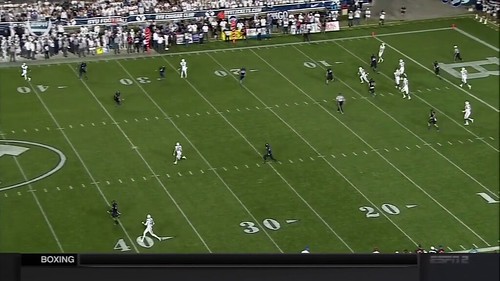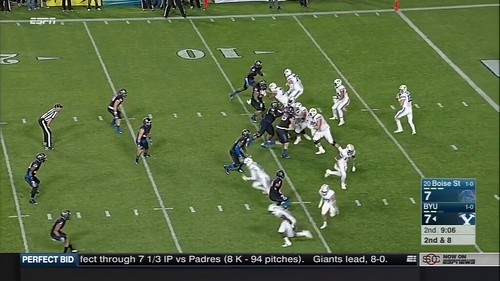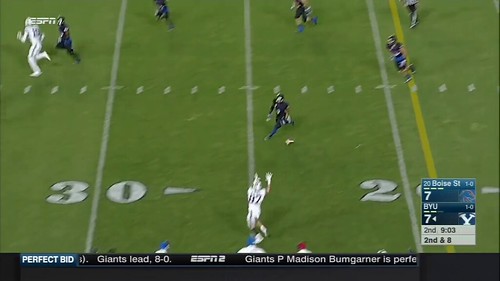Fee Fi Foe Film: BYU Offense

Yes, they did it again. Before last week's loss to UCLA, which wasn't readily available in torrent form, BYU tallied their second straight last-gasp comeback win, knocking off Boise State a week after connecting on a Hail Mary against Nebraska.
While BYU's 381 yards on 5.6 YPP was a respectable figure against a solid team, the way they got there is notable: a few huge plays, no small amount of luck, and little else. Here are all of their drives against Boise:
- 3 plays, 75 yards, 84-yard TD pass
- 4 plays, 11 yards, interception
- 3 plays, 7 yards, punt
- 6 plays, 19 yards, punt
- 3 plays, 5 yards, punt
- 6 plays, 17 yards, interception
- 5 plays, 2 yards, punt
- 3 plays, 8 yards, punt
- 3 plays, 9 yards, punt
- 6 plays, 84 yards, 21-yard rush TD set up by a 70-yard pass on 3rd-and-19
- 8 plays, 32 yards, punt
- 5 plays, 12 yards, QB sneak TD set up by BYU interception and two BSU penalties
- 6 plays, 13 yards, punt
- 7 plays, 64 yards, 35-yard TD pass on fourth down
Three of their four scoring drives involved a huge pass play over the top; the other was a 12-yard drive set up by an interception, and Boise State was in great position to hold BYU to a field goal before taking a personal foul penalty for continuing to play without a helmet.
While Tanner Mangum has filled in admirably—and sometimes spectacularly—at quarterback, this team really misses Taysom Hill, especially in their run game.
Personnel. Seth's diagram [click to embiggen]:
We debated shifting Wormley out to SDE and inserting Matt Godin at three-tech after Willie Henry was pulled for big stretches of the UNLV game, but M's defense stays unchanged for now. With the amount BYU throws the ball around—and how much trouble Henry had on the backside of zone runs—it wouldn't be surprising to see Godin, a good interior pass-rusher, get a lot of snaps.
Spread, Pro-Style, or Hybrid? Spread-to-pass. With Hill out, BYU was throw-first, and only some of that can be attributed to them playing from behind for most of the game.
Basketball on Grass or MANBALL? A mixture of both but BYU leaned towards zone blocking in this one.
Hurry it up or grind it out? BYU runs a no-huddle but doesn't go to light speed; having a freshman quarterback likely slows them down a bit.
[Hit THE JUMP for the rest of the breakdown.]
Quarterback Dilithium Level (Scale: 1 [Navarre] to 10 [Denard]): Mangum isn't Hill by any stretch. While BYU can still run the (very) occasional read option, Mangum isn't much of a threat on designed runs. Where his mobility serves him best is escaping the pocket; he's especially dangerous when he rolls to his right. UCLA took note of this last week and made a concerted effort to shut that down:
UCLA bottled up BYU freshman Tanner Mangum, the Hail Mary virtuoso, by keeping him in the pocket. Bruins defensive coordinator Tom Bradley saw on video that in the first two games, Mangum went 13-of-28 when he stayed in the pocket, and 9-of-11 when he rolled to his right. UCLA allowed Mangum to roll to his right only four times. The first three, he went 1-for-3 with one pick. The last came on 4th-and-7 from the Bruin 42 with 1:09 to play and BYU trailing, 24-23. Or, as it was formerly known, Hail Mary time. Mangum rolled to his right and slung it downfield -- right to linebacker Myles Jack.
Mangum is averaging 2.3 yards per non-sack carry. He gets a 5 on the Dilithium Scale.
Dangerman: Pick a giant receiver or go with shifty slot guy Mitchell Juergens, who leads the team with 244 yards through three games. He snuck behind the Boise State defense for BYU's first huge pass play—yes, on a Mangum rollout:
Mangum has a cannon. Boise State had a couple huge breakdowns in this one. Juergens took advantage, showing off good speed and later, on the desperation heave, some solid ball skills. He's the best BYU receiver in the short and intermediate areas, as well.
With BYU so big-play reliant, Michigan also must make sure they don't give up anything too easy to one of their three 6'5 or taller receivers who gets major playing time. The best of those is Mitch Mathews, who already has three touchdowns. Also key for Michigan: not falling asleep and letting a receiver go over the top:

That is the aforementioned 70-yard pass on 3rd-and-19; Devon Blackmon had to wait under it like a punt and still managed to get a ton of YAC. BYU's receivers are tough to contain for 60 minutes but I'm confident Michigan can do so better than Boise, whose safeties weren't so good at the cardinal safety rule of keeping everything in front of them.
Zook Factor: Nothing of major note here.
HenneChart: As you probably guessed, Mangum was boom-or-bust. The chart is what you'd expect of a high-upside freshman who can armpunt the ball to his power forwards wide receivers if need be:
| Opponent | DO | CA | MA | IN | BR | TA | BA | PR | SCR | DSR |
|---|---|---|---|---|---|---|---|---|---|---|
| Boise St. | 1 | 15 (1) | 3 | 8x | 2x | 3 | -- | 3 | 1 | 53% |
Mangum has a heck of an arm, which he puts on display not only on deep throws but also by zinging intermediate hitches and outs before the defense can arrive. He's prone to throwing the ball high and he'll miss his fair share of targets. His deep ball isn't totally consistent; he's prone to doing the Jake Rudock thing where he'll leave one long when ideally he'd hang it up short and let his receiver utilize his height advantage.
Mangum threw two picks in this one. The first was a back-footed long ball he left short—yes, I'm aware I just said he had the opposite problem, so you have to trust me here—and his receiver couldn't recover in time to undercut the defensive back. The second was an awful decision after he rolled out:
That was the BRX. Mangum also had a habit of holding onto the ball too long, as young mobile quarterbacks often do; he ate a sack on a three-man rush when one of the defenders in coverage said "to hell with this," shot a gap, and took him down at least a full second after the ball should've been thrown away.
OVERVIEW
BYU operates almost exclusively out of the shotgun, going to the pistol usually in short running situations.
| Formations | Run | Pass | PA |
|---|---|---|---|
| Gun | 20 | 28 | 6 |
| I-Form | -- | -- | -- |
| Ace | -- | -- | -- |
| Pistol | 8 | 1 | 1 |
| Heavy | 2 | -- | 1 |
They kept a decent run-pass balance in this game despite the running game taking a half to get going, but the pass really opened up the run for them, not the other way around.
| Down | Run | Pass | PA |
|---|---|---|---|
| 1st | 12 | 11 | 3 |
| 2nd | 11 | 9 | 4 |
| 3rd | 7 | 8 | 1 |
It's all about the explosive play for BYU. The passing game was either heaves down the field or short, easy stuff that didn't reliably move the sticks. BYU's offensive line doesn't help the passing game much. Mangum rolls right so often in part because they tend to allow pressure. Their right guard, especially, had trouble keeping contact with his man:
He also had trouble keeping his hands to himself and showing basic human decency.
I've covered what you need to know about the wideouts above; Juergens is a good all-around threat and the rest of the group can go up and get the ball. The tight ends weren't featured in the passing game at all but they were useful as blockers on a couple outside runs.
Boise State shut down the BYU rush attack in a way that seems very repeatable by Michigan. BYU couldn't get to the second level on their inside runs; they could get a tiny bit of push but couldn't get combo blocks that spring running backs free, and if one guy messed up, the play was dead:
Until BYU's last drive, their best run came when running back Adam Hine—who showed a nice power/speed combination when he actually had the chance to do something—busted through a tackle in the hole, broke another, and found the sideline for a 21-yard score; a nice play but not one that made you think the offensive line was doing particularly well. BYU had a couple more chunk runs late but mostly because Boise was playing pass.
The key for Michigan is simple: don't bust a coverage. BYU didn't show they can reliably put up points or move the ball without getting huge plays on breakdowns in the secondary. Usually those busts were rather inexplicable; the following play actually involved some nice play design.
PLAY BREAKDOWN
BYU comes out with four receivers all bunched to the near side:

This setup can cause confusion whether a defense is in man or zone. Against man it's easy to pick off a defender with a rub route; against zone it's easy to flood a specific zone and give a defender a difficult choice. In this case they catch BSU in a zone. At the snap, the inside receiver runs a bubble screen, the two other receivers lined in front take off down the field, and the guy in the back of the diamond—Juergens—runs the ever-unstoppable wheel route.

The two deep routes occupy the safeties while the bubble holds the attention of the cornerback (#4) who lined up over the bunch.

Said corner comes to the sudden realization he should be following the wheel instead of playing the bubble—which a linebacker is taking—but he gets turned around and can't find Juergens, who's wide open down the sideline.

You can see the seam route taking the safety way out of the area. If BYU needed a checkdown, the running back slipped out of the backfield and was open for a decent gain, too.
Video:
Don't bust coverages, please.
September 23rd, 2015 at 10:22 PM ^
September 23rd, 2015 at 10:35 PM ^
So maybe we can feel a little OK that we have a couple of tall-ish guys playing #2 corner who seem to be improving nicely
September 24th, 2015 at 12:47 AM ^
Mangum throws the ball in the aeroplane over the sea.
September 24th, 2015 at 6:47 AM ^
Sent from MGoBlog HD for iPhone & iPad
September 24th, 2015 at 1:23 AM ^
Man this will be a real test for Michigan.Looking forward to another Michigan football Saturday, Go Blue!
September 24th, 2015 at 8:17 AM ^
1. The QB really gets the ball out quickly and he seems to have a grasp of his reads. He has a good arm and improved from game 2/3. Tough guy to rush.
2. The WRs are very tall so there are natural windows.
3. They balance the run and pass very well.
4. #28 is an exceptional RB. Maybe better than the kid at Utah.
5. They really shut down Josh Rosen.
However,
1. #72 holds like a demon---I hope/expect for one drive killer there.
2. #7 on D gets lost when in man coverage.
3. They had trouble with the UCLA run game. However, how much we can explot that is unclear---to me at least.
I think this is a pretty close game. I would probably pass on it but never lay the 5.5.
September 24th, 2015 at 8:30 AM ^
What in god's name was the safety doing on that first BYU touchdown? It's like he turns around just for the fun of it.
September 25th, 2015 at 11:22 AM ^

Comments